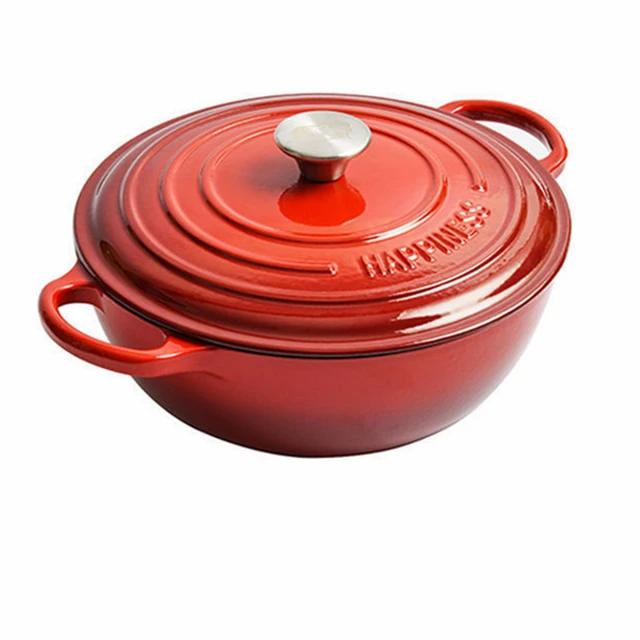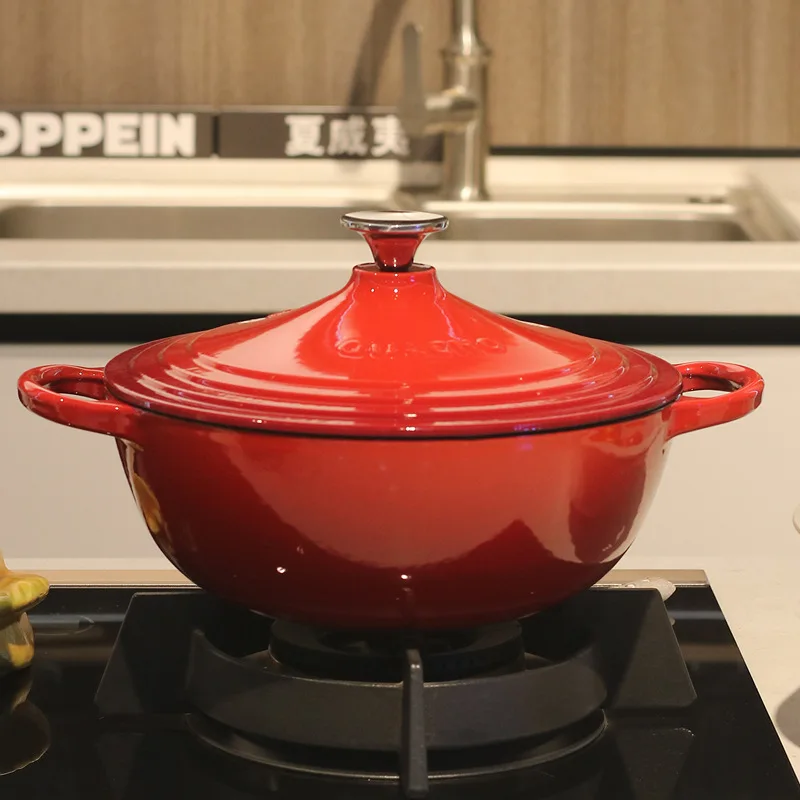Introduction:
A Dutch oven is a versatile and beloved cooking vessel that has been used for centuries. It is known for its durability, even heat distribution, and ability to retain heat, making it a favorite among professional chefs and home cooks alike. In this article, we will explore what makes a Dutch oven special, discussing its unique features, benefits, and various applications in the kitchen. From its construction to its versatility in cooking methods, the Dutch oven stands out as a cherished and indispensable tool for culinary enthusiasts.

What is special about a Dutch oven?
Historical Background:
Origin: The Dutch oven originated in the Netherlands in the 17th century and was introduced to America by European settlers. Its design and construction have evolved over time, but the Dutch oven’s fundamental qualities have remained constant.
Construction and Design:
a. Material: Dutch ovens are typically made from cast iron, a durable and heat-retentive material that ensures even heat distribution during cooking. The weight of cast iron contributes to its ability to hold and distribute heat effectively.
b. Thick Walls and Lid: Dutch ovens have thick, heavy walls and a tight-fitting lid. The thickness of the walls allows for optimal heat retention, while the lid helps create a sealed environment, preventing moisture from escaping during cooking.
c. Handles and Bail Handle: Dutch ovens feature sturdy handles on the sides for ease of handling and transport. Additionally, some Dutch ovens have a bail handle, which allows for hanging the pot over an open fire.
Heat Retention and Distribution:
a. Even Heat Distribution: The thick walls and heavy construction of a Dutch oven help distribute heat evenly throughout the cooking process. This promotes uniform cooking and prevents hot spots that can lead to unevenly cooked food.
b. Heat Retention: Dutch ovens excel at heat retention, allowing food to continue cooking even when removed from direct heat. This makes them ideal for slow cooking, braising, and simmering dishes that benefit from long, gentle cooking times.
c. Suitable for Various Heat Sources: Dutch ovens are versatile in terms of heat sources.
Versatility in Cooking Methods:
a. Baking and Roasting: Dutch ovens can be used for baking bread, cakes, and other baked goods. The even heat distribution and heat retention properties of the Dutch oven create a moist and controlled baking environment, resulting in beautifully risen bread and perfectly baked pastries.
b. Deep Frying: The Dutch oven’s deep and wide shape, along with its ability to retain heat, makes it an excellent vessel for deep frying. The generous capacity allows for frying larger quantities of food, while the heat retention ensures consistent frying temperatures.
c. One-Pot Meals: The Dutch oven’s versatility allows for the creation of one-pot meals. From hearty stews to casseroles and risottos, the Dutch oven can accommodate various ingredients and cooking techniques, reducing the need for multiple pots and pans.
Durability and Longevity:
a. Cast Iron Construction: Dutch ovens are made from cast iron, a material known for its durability and longevity. With proper care, a Dutch oven can last for generations, making it a cherished heirloom in many families.
b. Non-Stick Properties: Over time, the seasoned surface of a Dutch oven develops a natural non-stick coating. This reduces the risk of food sticking and makes cleaning easier.
c. Versatility in Maintenance: Dutch ovens do require specific care to maintain their integrity. Regular seasoning and proper cleaning techniques, such as hand washing and gentle scrubbing, help prevent rust and maintain the non-stick surface.
Aesthetic Appeal:
a. Classic and Timeless Design: Dutch ovens have a classic and timeless design that adds a touch of nostalgia and charm to the kitchen. Their rustic appearance can enhance the presentation of dishes, making them suitable for serving directly at the table.
b. Variety of Colors and Finishes: Dutch ovens are available in a wide array of colors and finishes. From vibrant hues to sleek matte finishes, there is a Dutch oven to suit every kitchen aesthetic and personal style.
Outdoor Cooking and Camping:
Portability: Dutch ovens are popular for outdoor cooking and camping due to their durability and ability to withstand high temperatures.
Essential Dutch Oven Recipes
Classic Beef Stew
A classic beef stew is a comforting dish made for cold nights. The Dutch oven perfectly serves this recipe, as it keeps everything at the ideal temperature. Begin by browning cubes of beef in the pot until they reach a rich color. Next, add onions, carrots, and potatoes. Pour in beef broth, seasonings, and let it slow-cook for hours. The final product will be tender meat in a luscious gravy.
What makes this recipe special is the depth of flavor it develops. As it cooks, the meat breaks down while absorbing all the ingredients. Each bite offers a delightful combination of textures and tastes. You can also experiment by adding mushrooms or herbs for a unique twist.
No-Knead Bread
No-knead bread is another simple yet impressive recipe for the Dutch oven. It requires minimal ingredients and effort. Mix flour, water, yeast, and salt to create a shaggy dough. Let it rise for about 12 hours, covered. After the initial rise, shape the dough and place it in a preheated Dutch oven. Bake and enjoy the aromatic smell filling your kitchen.
This method is perfect for beginner bakers. It removes the intimidation often associated with bread-making. As a result, you can easily impress family and friends with your skills. The golden crust and soft interior will leave everyone yearning for more.
Maintenance and Care for Dutch Ovens
Proper Cleaning Techniques
Caring for your Dutch oven is crucial for its longevity. To preserve its beauty and performance, specific cleaning techniques should be employed. After cooking, let the pot cool before washing. This prevents thermal shock that can damage the material. Use warm, soapy water along with a soft sponge for cleaning. Avoid harsh abrasives that could scratch the enamel or cast iron surfaces.
When it comes to stubborn food residue, soak the pot rather than scrubbing vigorously. This gentler approach helps to lift burnt-on bits without damaging the finish. For cast iron versions, avoid using soap too frequently. Rinse and dry it thoroughly, as moisture can lead to rust. Lastly, you can apply a thin layer of oil to keep the surface seasoned and protective.
Seasoning and Restoration
For seasoned cast iron Dutch ovens, regular upkeep is essential. Over time, they may require re-seasoning to maintain a non-stick surface. To do this, scrub it thoroughly to remove any food residue. Then, apply a thin layer of vegetable oil and heat it in the oven. This process forms a new protective coating that ensures effective cooking.
If your Dutch oven shows signs of wear or rust, don’t despair. You can restore it with some effort. Start by removing rust with steel wool. Next, wash and dry it completely before applying oil and re-seasoning. With a little patience, your Dutch oven can be brought back to life. This maintenance increases its lifespan and efficiency.
The Dutch Oven in Contemporary Kitchens
Reviving Traditional Cooking Methods
In an age of modern appliances, the Dutch oven stands the test of time. Many chefs and home cooks are reviving traditional cooking methods by using it. This trend reflects a desire for authenticity in gastronomy. People are increasingly interested in slow-cooked meals that evoke nostalgia. Therefore, the Dutch oven continues to hold an important place in kitchens.
Many cooking shows and blogs highlight the versatility of this tool. From soups to braises, it showcases many culinary possibilities. More importantly, it encourages a cooking style that values patience and care over convenience. Those who embrace this approach often enjoy a deeper connection to their meals.
A Gathering Tool for Family and Friends
Beyond its cooking capabilities, the Dutch oven serves as a social centerpiece. Friends and family gather around the pot to share stories and meals. This communal aspect ties it to home cooking and gatherings. The mere sight of a bubbling stew or hearty casserole sparks joy among loved ones.
Furthermore, it encourages shared experiences in the kitchen. Cooking together allows families to bond while preparing a meal. The Dutch oven fosters a sense of togetherness that fast-paced modern cooking often overlooks. Thus, it remains a cherished tool that creates lasting memories.
Conclusion:
The Dutch oven’s construction, heat retention, even heat distribution, and versatility make it a special and beloved cooking vessel. Its cast iron construction and thick walls ensure durability and longevity, while its ability to retain heat allows for slow cooking and tenderizing tough cuts of meat. From braising and stewing to baking and frying, the Dutch oven excels in a wide range of cooking methods. Its versatility extends beyond the kitchen, making it a favorite for outdoor cooking and camping. With proper care and maintenance, a Dutch oven can become a cherished culinary tool that lasts for generations.

